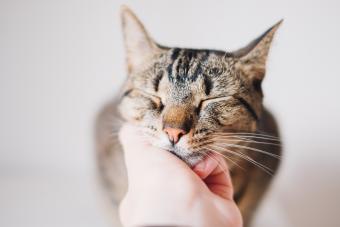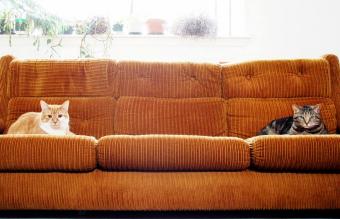
If you love your kitty, of course you want her to be a happy cat! Sometimes it's hard to tell if a cat is happy though, especially if you have a more aloof and introverted feline.
Cat Happiness and Body Language
Learning about cat body language can help you see when your cat truly is enjoying himself. A cat uses their body language to communicate a lot about their emotional state.
The Happy Cat's Tail Posture
If a cat is scared, their tail will be tucked under their body. If it's stressed or feeling defensive, it may stick their tail straight up and it will be stiff with the hair "on end." But a happy cat is clearly happy when their tail is standing straight up in a calm, relaxed posture. You may even see it gently swishing a bit back and forth. It's sometimes referred to as the "question mark" position as the tail sort of curls a bit at the top like a "?".
Happy Cat Whisker Position
If a cat is feeling relaxed and happy, their whiskers will be held off to the sides, rather than forwards or back against their chins.

A Cat's Tongue
If you notice your cat lying down and snuggling his tongue is showing, that's a truly relaxed cat! A stressed cat would keep their mouths closed and tight. A tongue can only stick out when the cat is feeling good enough to keep his head muscles calm and loose.

Cat Ear Position
When a cat is feeling completely relaxed and content, their ears will be in a "neutral" position. They will point neither too far forward or too far back.

Dilated Cat Eyes
Some cats can show dilated eye pupils when they're feeling excited and playful. Of course they can also do this when they're feeling a bit too excited, over-aroused, scared or aggressive. As with their other body movements, you have to take them in the context of what else is happening in the environment and your cat's other body language signs.
Cat Body Position
A cat that is nervous will not lie on their back with their belly exposed. If you observe your cat lounging on the bed or couch with their belly up, paws curled in and they're purring away, this is one happy feline! Another common sleeping position that indicates your cat is relaxed is the "bread loaf" where they tuck their legs under them, move their ears slightly forward and down, close their eyes and begin to purr.
Cats That Vocalize Their Happiness
Cats can also use vocalization to let you know how they're feeling. Some breeds, like the Siamese, are more vocal than others, but all breeds do use sound to communicate.
A Happy Cat Purrs
The sound of purring is usually a clear indication that your cat is happy. Sometimes cats can purr if they feel anxious, so make sure you're looking for a purr in the right context. A cat that purrs when it's snuggling with you, or while it's enjoying a grooming session, is definitely a cat that is glad to be with you.
Chirping and Trilling
These are noises that cats make when they're in a generally good mood. You may hear them between a mother cat and her kittens. Some adult cats will actually have "conversations" with these noises, as if they're having a friendly chat between felines.
Happy Cat Behaviors
A cat that's content will engage in several behaviors that clearly let you know that they're a very happy kitty.
Curling Up
A cat that is happy will have no qualms about jumping up on your lap and cuddling in for the long haul. They also will love getting in bed with you at night and being close. If your cat always wants to be on you and loves snuggling, that's an excellent sign your cat is happy.

Blinking Cats
Some people refer to a cat blinking at you as a "kitty kiss." If you try blinking at a cat, you may find them responding by blinking slowly back. This is a behavior that cats do between each other as well to indicate that all is well.
Yawning Cats
A relaxed cat will yawn with a big open mouth, as if he's saying he's chill enough to take his time to take a good long, wide yawn.
Moving About the Environment
A cat that is nervous, fearful, aggressive or unsure will not move freely around their home or environment. If your cat walks around the house and explores as if she "owns the place," this is a cat that is relaxed and content. She may also just jump up on a cat tree and quietly observe the comings and goings in the house which indicates she's having a good time "people watching" and isn't fearful or put off by her surrounding.
Extending the Head
A cat that moves its head in a forward position when greeting you is a cat that is friendly and eager to meet you. Their head movement makes it very clear they are not afraid or stressed and want to interact with you which is a definite sign of cat happiness.
Rubbing and Head Butting Against You
If your cat begins to rub up against you, this is a sign they're happy and enjoying your company. What they're actually doing is marking you with their scent, but this just means they want the world to know they think you're the best and want to keep you.

Nibbling You
Some cats, especially kittens, may nibble on your fingers and hands. This is a sign of affection even if you may find it unpleasant. Usually kittens grow out of it and all you need to do is redirect them onto a toy. You don't want them to think you're rejecting their love, just finding a more appropriate outlet for it.

Making Biscuits
Cats will knead their paws on surfaces like their beds, other cats or pets, or humans. This cute behavior is called "making biscuits" by cat lovers. This behavior stems from kittenhood and would be done to stimulate milk production from their mother. It's a calming behavior that cats do when they're feeling completely relaxed.
Happy Cats Play!
An easy and obvious sign your cat is happy is when they start to play. A cat that loves playing with other cats, pets or with you and your family is a cat that is definitely having a good time. The wonderful thing about play is, the more you play with your cat, the more likely it is he or she will play with you and it's a great bonding activity.
Happy Cats Love to Learn
Another good sign your cat is happy is if you can work with him to teach tricks. Cats may take a bit of time to acclimate to training compared to a dog, but being intelligent creatures, many cats really learn to enjoy clicker training. If you pull out a clicker and some treats and your cat comes running over, ready for a training session, this is a sign you not only have a happy cat but a mentally engaged one as well.
Loving Cat Gifts
If you have an indoor-outdoor cat, one unpleasant way that they may let you know they love you is the practice of leaving "gifts." Usually these are left in unfortunate places like your bed or the kitchen. If your cat regularly drops rodents and other small critters they've caught for you, it's best to grin and bear it because, as gross as you may find it, they truly are leaving you something they consider a treasure and they feel safe enough to leave it with you for later.

Everyday Behaviors of Happy Cats
Another way to tell if your cat is happy is if they are engaging "normally" in all the usual activities that they would on any given day.
Eating Regularly
A cat that is stressed will have a diminished appetite, or will only eat when it can't be observed, such as late at night. If your cat saunters up to their bowl and eats heartily, this is a good sign you have a happy, healthy cat.

Grooming Themselves
Grooming is important to cats and often one of the first signs a cat is ill is that they stop grooming. Cats that are fearful or upset will also stop grooming. If you see your cat regularly grooming himself day after day, and out in the open without any fear, this is a well-adjusted, happy cat. In addition to grooming themselves, you may also find them licking and grooming you, which is just another sign they consider you worthy of some extra help.

No Litter Box Issues
Another sign that often indicates a cat is ill or behaviorally stressed is ceasing to use the litter box. If your cat is using the box with no problems day after day, this is a good sign that your cat is doing well.

A Happy Cat Is the Best Kind of Cat!
If you're not sure if your cat is happy or not, take a look at all of their different body language, vocalizations and behaviors to see how they compare to what a happy cat does. If you notice your cat isn't engaging in all of them, not all cats are the same, but it's worth it to take a look at their daily exercise, enrichment, play and cuddling time to see if there's more you could do to improve their lives. Changes in everyday behaviors is also a key sign that a cat is, or is not, feeling content and healthy so any changes in eating, drinking, grooming or litter box use are clear indicators that you need to take action to care for your kitty and make him a happy feline.







